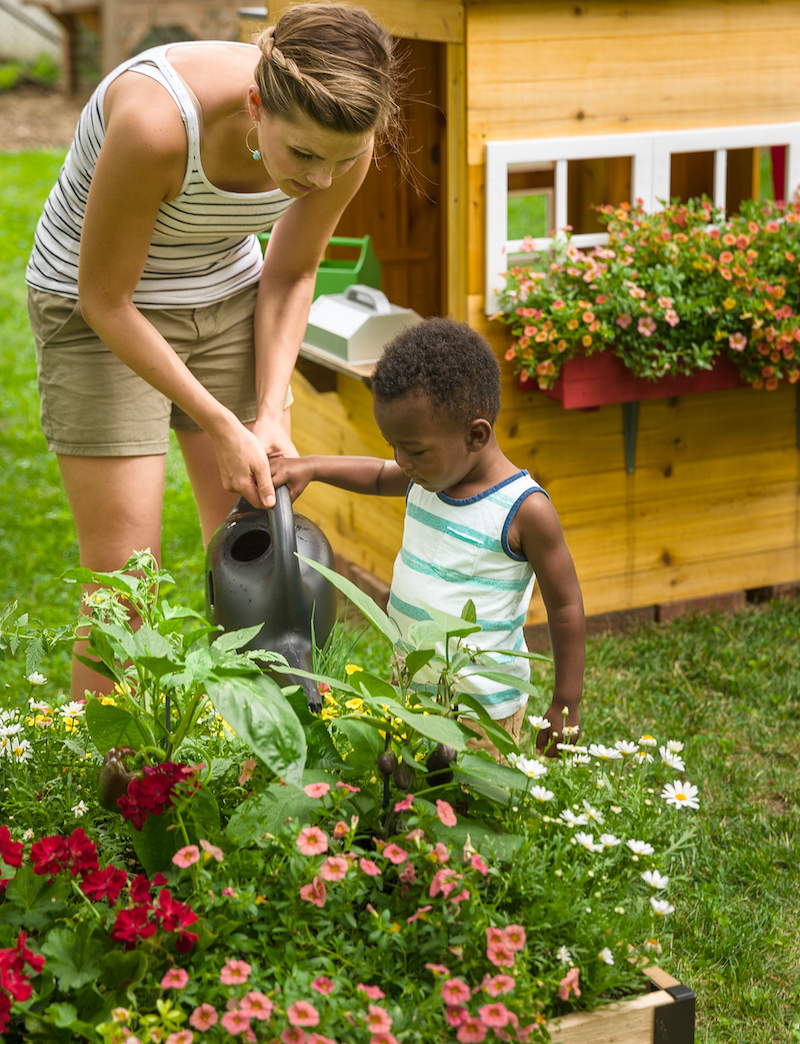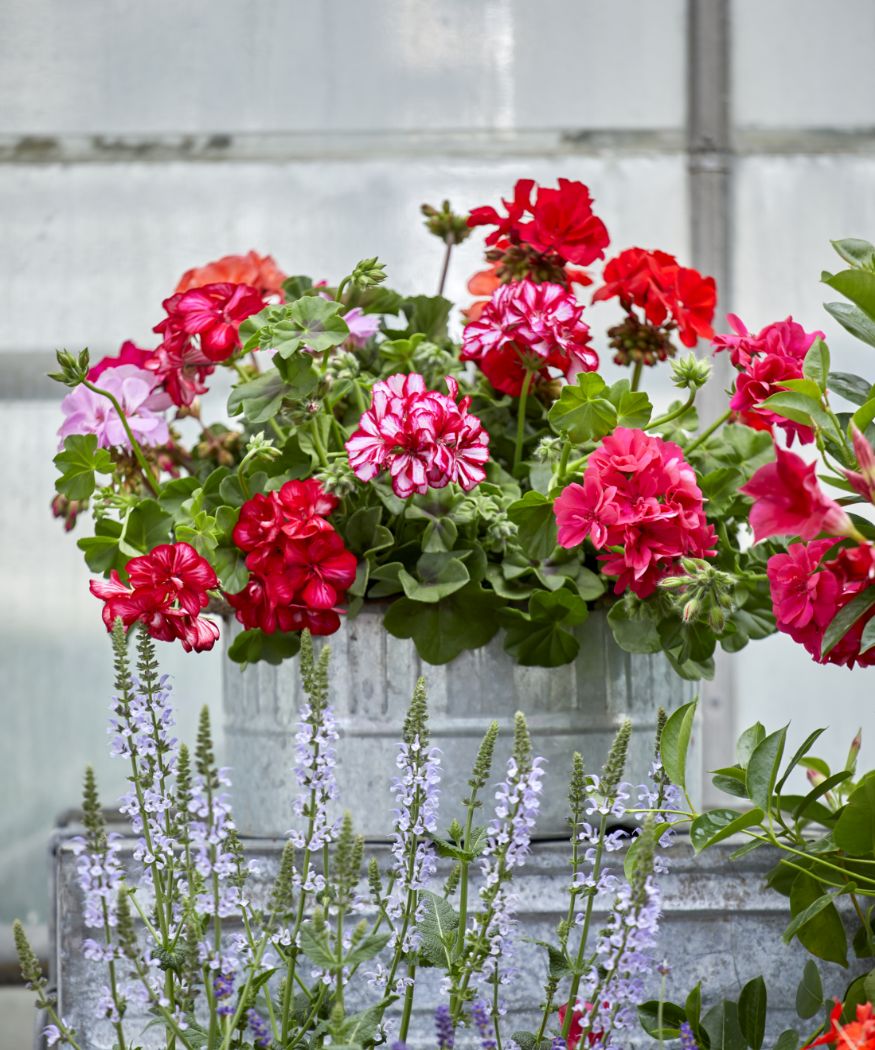To water geraniums, thoroughly soak the soil, allowing it to dry out slightly between waterings. Geraniums prefer well-draining soil and should be watered deeply once or twice a week during dry spells.
Beautiful and vibrant geraniums are a popular choice among garden enthusiasts. These versatile flowers come in a variety of colors and can be easily grown in containers or garden beds. However, knowing the proper watering techniques for geraniums is crucial to keep them healthy and flourishing.
We will discuss the best practices for watering geraniums, ensuring their optimum growth and vitality. By following these simple guidelines, you can provide your geraniums with the right amount of moisture and contribute to their overall well-being. Let’s dive in!

Credit: plantaddicts.com
The Importance Of Proper Watering For Healthy Geraniums
Geraniums are beautiful and vibrant plants that require proper watering to thrive. Understanding the different water needs in different seasons is crucial for their overall health.
Spring: During the spring season, geraniums are actively growing and require consistent watering. The soil should be kept slightly moist, but not waterlogged. Overwatering can lead to root rot, so ensure proper drainage.
Summer: In hotter months, geraniums need more water to combat evaporation. Water deeply and allow the top inch of soil to dry slightly between waterings. However, be cautious of overwatering, as excess moisture can result in fungal diseases.
Fall: As the weather cools down, reduce watering frequency. Geraniums go dormant in the fall, so water sparingly. This will prevent excess moisture and allow the plants to prepare for winter.
Winter: Geraniums require minimal water during the winter months. Water sparingly to keep the soil from completely drying out. Overwatering during this time can cause root rot and damage the plants.
Proper watering is essential for healthy geraniums. Understanding their changing water needs throughout the seasons will help you maintain vibrant and thriving plants. Remember to always observe the soil moisture levels and adjust your watering accordingly.
Factors To Consider When Watering Geraniums
Proper watering is essential for the healthy growth of geraniums. Here are a few factors you should consider:
| Soil Moisture Levels | Weather Conditions | Type of Pot or Container |
| The soil should be kept consistently moist, but not waterlogged. | Take into account the weather conditions before watering. Geraniums may need more water during hot or dry periods. | Choose a pot or container with drainage holes to prevent waterlogging. This allows excess water to drain away. |
| Avoid overwatering, as it can lead to root rot and other problems. | During periods of heavy rain, reduce watering or move your geraniums to a sheltered area to avoid excessive moisture. | Consider using a moisture meter to check the moisture level in the soil and adjust watering accordingly. |
| Water the geraniums deeply, ensuring that the water reaches the entire root zone. | Monitor the weather forecast and adjust watering frequency based on expected rainfall. | Choose a pot or container with good drainage to prevent water from sitting in the bottom. |
By considering these factors, you can ensure that your geraniums receive the right amount of water for optimal growth and health.
How to Water Geraniums: Step by Step Guide
Watering Techniques For Geraniums
When it comes to watering geraniums, it is important to follow the right techniques to ensure their health and vitality. One crucial aspect is the timing and frequency of watering. Geraniums should be watered in the early morning or late evening, avoiding the peak heat of the day. This allows the plants to absorb water before it evaporates and prevents moisture-related diseases.
In terms of frequency, geraniums prefer to be watered deeply but infrequently. Watering them once or twice a week is usually sufficient, as they prefer slightly drier conditions. Overwatering can be detrimental to geraniums as it can lead to root rot and other issues. To prevent overwatering, it is important to ensure proper drainage in the pots or garden beds where the geraniums are planted.
There are several watering methods that can be used for geraniums. The most common method involves applying water directly to the soil at the base of the plant, rather than overhead watering which can result in wet foliage and increase the risk of fungal diseases. Drip irrigation or using a soaker hose can help deliver water directly to the root zone, promoting healthy growth.
| Timing and frequency | Water in the early morning or late evening to avoid peak heat and water once or twice a week. |
|---|---|
| Watering methods | Apply water directly to the soil at the base of the plant using drip irrigation or a soaker hose. |
| Overwatering prevention | Ensure proper drainage in pots or garden beds to prevent overwatering and related issues. |
Signs Of Underwatered Geraniums
Signs of underwatered geraniums include wilted leaves, dry soil, and slow growth. Wilted leaves are a clear indication that the geraniums are not receiving enough water. The leaves may appear droopy and lackluster. Checking the soil is another way to determine if your geraniums need more water.
Dry soil tends to be light and crumbly, indicating that it lacks moisture. Geraniums may also exhibit slow growth when they are not getting adequate water. The lack of hydration hinders their ability to absorb nutrients and thrive. To prevent underwatering, make sure to water your geraniums regularly, keeping the soil evenly moist but not waterlogged.
Signs Of Overwatered Geraniums
Overwatering geraniums can lead to various signs that indicate the plant is receiving too much water. One of the common signs is yellowing leaves. When geraniums receive excess water, their leaves start turning yellow, indicating stress and nutrient deficiencies. Another sign is root rot. Overwatering can cause the roots to become saturated, leading to root rot, which is characterized by a foul odor and dark, mushy roots. It is essential to avoid overwatering to prevent root rot and maintain the plant’s health.
Additionally, overwatering can create a moist environment conducive to mold growth. Mold can appear on the leaves and soil surface, leading to further damage. To prevent overwatering, it is important to water geraniums sparingly, allowing the top layer of soil to dry before watering again. Regularly inspecting the plant for signs of overwatering can help maintain its health and vitality.
Understanding Proper Soil Moisture Levels
Proper soil moisture levels are crucial for the health and growth of geraniums. Testing the soil moisture regularly is important to ensure optimal conditions for these plants. To test soil moisture, simply insert your finger into the soil up to the second knuckle. If the soil feels dry, it’s time to water the geraniums. However, it’s equally important to avoid overwatering, as this can lead to root rot and other issues. If the soil feels wet, it’s best to wait before watering.
In addition to testing soil moisture, adding organic matter to the soil can help improve drainage. This can be done by incorporating compost or well-rotted manure into the soil before planting. The organic matter will increase the soil’s ability to hold moisture while also allowing excess water to drain away. Maintaining proper soil moisture levels will help ensure healthy and vibrant geranium plants.
Timing And Frequency Of Watering
Watering geraniums at the right time and frequency is crucial for their overall health and growth. When it comes to watering, there are a few important considerations to keep in mind.
The timing of watering can make a significant impact on the well-being of your geraniums. Ideally, it is recommended to water them in the morning rather than in the evening. This allows the leaves and soil surface to dry out during the day, reducing the risk of fungal diseases.
Adjusting the watering schedule based on the different seasons is also important. Geraniums have varying water requirements during hot summers and cool winters. In summer, more frequent watering may be necessary to compensate for evaporation and heat stress. During winter, reduce the frequency of watering as the plant enters a dormant state.
It’s worth noting that each geranium plant may have its own specific water needs, so it’s essential to monitor the moisture levels in the soil. When watering, ensure that the soil is evenly moist, but not waterlogged, as excessive moisture can lead to root rot. Remember to water at the base of the plant, not over the foliage, to avoid causing damage.
Choosing The Right Watering Method
When it comes to watering geraniums, choosing the right method is crucial. Two common methods include drenching and bottom watering. Drenching involves pouring water over the soil until it runs out of the drainage holes. This method quickly saturates the soil and allows excess water to drain away. On the other hand, bottom watering involves placing the pot in a tray filled with water and allowing the plant to absorb moisture through its roots. This method prevents water from splashing onto the leaves, which can lead to fungal diseases.
To avoid overhead watering, it is important to use a watering can or a hose with a nozzle that provides a gentle flow of water. Direct the water towards the base of the plant, avoiding the leaves as much as possible. Overhead watering can cause water to accumulate on the leaves, creating a moist environment that encourages the growth of diseases.
Important tips for watering geraniums:
- Water geraniums only when the top inch of the soil feels dry to the touch.
- Ensure proper drainage by using pots with drainage holes.
- Apply water slowly and evenly to allow the soil to absorb it properly.
- Avoid waterlogging or excessively wetting the soil.
By following these guidelines and choosing the right watering method, you can ensure that your geraniums thrive and remain healthy.
Frequently Asked Questions For How To Water Geraniums
What Is The Proper Way To Water Geraniums?
Water geraniums deeply once or twice a week, allowing the top inch of soil to dry out between watering. Avoid overwatering, as it can lead to root rot. Water at the base of the plant, avoiding the leaves. Use well-draining soil and only water when needed to maintain healthy geraniums.
How Often Do You Need To Water Geraniums?
Water geraniums every 5 to 7 days during the summer months. Adjust frequency based on weather conditions. Be sure to check soil moisture before watering to avoid overwatering the plants.
Should Geraniums Be Watered From Top Or Bottom?
Geraniums should be watered from the bottom to avoid getting the leaves wet, which can lead to fungal diseases. Watering from beneath allows the plants to absorb water through their roots more effectively.
How Often Do You Water Geraniums In Hanging Baskets?
Water geraniums in hanging baskets when the top inch of soil feels dry to the touch. Generally, it’s best to water them every 2-3 days, but adjust according to weather conditions.
Conclusion
To ensure the health and vibrancy of your geraniums, proper watering techniques are crucial. Remember, it’s always better to underwater than overwater. By following the simple guidelines outlined such as using well-draining soil and watering at the base of the plant, you can set your geraniums up for success.
Keep in mind that consistency is key, so establish a regular watering routine and monitor the moisture levels of your plants carefully. With a little attention and care, your geraniums will thrive and reward you with gorgeous blooms all season long.

